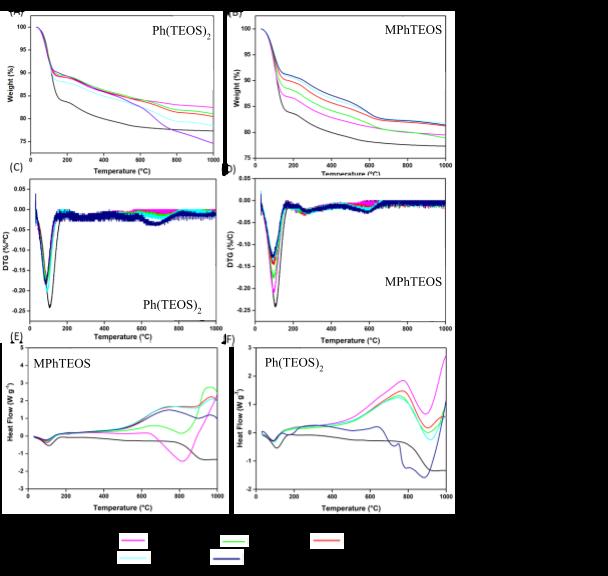
4 minute read
A2.-TGAyDSC


Advertisement
Bibliografía

Alemán, J V, Chadwick, A V, He, J, Hess, M, Horie, K, Jones, R G, & Stepto, R F T (2007)
Definitions of terms relating to the structure and processing of sols, gels, networks, and inorganic-organic hybrid materials (IUPAC Recommendations 2007). Pure and Applied Chemistry, 79(10),1801-1829
Brinker, C J, & Scherer, G W (2013) Sol-gel science: the physics and chemistry of sol-gel processing Academicpress.
Cheng, X, Chen, D, & Liu, Y (2012) Mechanisms of silicon alkoxide hydrolysis–oligomerization reactions:ADFTinvestigation.ChemPhysChem,13(9),2392-2404.
Clara Gonçalves, M. (2015). Physisorption data for methyl-hybrid silicagels. Journal of Sol-Gel Science and Technology, 75(3),508-518
Cruz-Quesada, G, Espinal-Viguri, M, López-Ramón, M V, & Garrido, J J (2021) Hybrid Xerogels: Study of the Sol-Gel Process andLocalStructurebyVibrationalSpectroscopy Polymers,13(13), 2082.
Cruz-Quesada, G., Espinal-Viguri, M., López-Ramón, M. V., & Garrido, J. J. (2021). Novel Organochlorinated Xerogels: From MicroporousMaterialstoOrderedDomains Polymers,13(9), 1415
Cruz-Quesada, G, Espinal-Viguri, M,López-Ramón,M V,&Garrido,J J (2022) NovelSilicaHybrid Xerogels Prepared by Co-Condensation of TEOS and ClPhTEOS: A Chemical and MorphologicalStudy Gels,8(10),677
De Lange, R S A (1995) Microporous sol-gel derived ceramic membranes for gas separation: Synthesis,gastransportandseparationpropertiess
Dudás, Z, Len, A, Ianăşi, C, & Paladini, G (2020) Structural modifications caused by the increasing MTES amount in hybrid MTES/TEOS-based silica xerogels. Materials Characterization, 167, 110519
Duque Salazar, A C (2001) Desarrollo de materiales a base de sílice para la adsorción de compuestos orgánicos Departamento de Ingeniería Química
Echeverría, J C, Calleja, I, Moriones, P, & Garrido, J J (2017) Fiber optic sensors based on hybrid phenyl-silica xerogel films to detect n-hexane: Determination of the isosteric enthalpy of adsorption Beilstein Journal of Nanotechnology, 8(1),475-484
Estella, J, Echeverría, J C, Laguna, M, & Garrido, J J (2007) Effects of aginganddryingconditions on the structural and textural properties of silica gels Microporous and mesoporous materials, 102(1-3),274-282.
Estella, J., Echeverría, J. C., Laguna, M., & Garrido, J. J. (2007). Silica xerogels of tailored porosity as support matrixforopticalchemicalsensors SimultaneouseffectofpH,ethanol:TEOSandwater: TEOS molar ratios, and synthesis temperature on gelation time, and textural and structural properties. Journal of non-crystalline solids, 353(3),286-294.
Fidalgo, A., & Ilharco, L. M. (2004). Chemical tailoring of porous silica xerogels: local structure by vibrationalspectroscopy. Chemistry–A European Journal, 10(2),392-398.

Fidalgo, A., Ciriminna, R., Ilharco, L. M., & Pagliaro, M. (2005). Role of the alkyl alkoxide precursor on the structure and catalytic properties of hybrid sol gel catalysts Chemistry of materials, 17(26),6686-6694.
Flores-López, S. L., Villanueva, S. F., Montes-Morán, M. A., Cruz, G., Garrido, J. J., & Arenillas, A. (2020). Advantages of microwave-assisted synthesis of silica gels. Colloids and Surfaces A: Physicochemical and Engineering Aspects, 604,125248
Gillanders, R N, Campbell, I A, Glackin, J M, Samuel, I D, & Turnbull, G A (2018) Ormosil-coated conjugated polymers for the detection of explosives in aqueous environments. Talanta, 179,426-429.
González Rojas, C. R. (2001). La tecnología de los sensores de fibra óptica (Doctoral dissertation, UniversidadAutónomadeNuevoLeón)
Innocenzi, P (2003) Infrared spectroscopy ofsol–gelderivedsilica-basedfilms:aspectra-microstructure overview. Journal of non-crystalline solids, 316(2-3),309-319.
Jiménez, P. M. (2016). Síntesis y caracterización de xerogeles silíceos híbridos (RTEOS/TEOS; R= P, Ph): separación y purificación de gases mediante cromatografía (Doctoral dissertation, UniversidadPúblicadeNavarra)
Judeinstein, P, & Sanchez, C (1996) Hybrid organic–inorganic materials: a land of multidisciplinarity Journal of Materials Chemistry, 6(4),511-525.
Jung, J., Won, J., & Hwang, S. S. (2020). Highly selective composite membranes using ladder-like structured polysilsesquioxane for a non-aqueous redox flow battery. Journal of Membrane Science, 595,117520
Kamiya, K, Dohkai, T, Wada, M, Hashimoto, T, Matsuoka, J, &Nasu,H (1998) X-raydiffractionof silica gels made by sol–gel method under different conditions. Journal of non-crystalline solids, 240(1-3),202-211.
Kickelbick, G. (2007) Hybrid Materials Synthesis, Characterization, and Applications; John Wiley & Sons:NewYork
Laird, M, Yokoyama, J, Carcel, C, Unno, M, Bartlett, J R, & Wong Chi Man, M (2020) Sol–gel processing of polyhedral oligomeric silsesquioxanes: nanohybrid materials incorporating T8 and T10cages. Journal of Sol-Gel Science and Technology, 95(3),760-770.
Larson,G.L.(Ed.).(2013). Silicon Compounds: Silanes and Silicones.Gelest.
Lin, W., Zheng, J., Zhuo, J., Chen, H., & Zhang, X. (2018). Characterization of sol-gel ORMOSIL antireflective coatings from phenyltriethoxysilane and tetraethoxysilane: Microstructure control andapplication. Surface and Coatings Technology, 345,177-182.
Lin, W., Zhang, X., Cai, Q., Yang, W., & Chen, H. (2020). Dehydrogenation-driven assembly of transparent and durable superhydrophobic ORMOSIL coatings on cellulose-based substrates. Cellulose, 27(13),7805-7821
Liu, Z, Tian, S, Li, Q, Wang, J, Pu, J, Wang, G, & Ren, L (2020) Integrated dual-functional ORMOSIL coatings with AgNPs@ rGO nanocomposite for corrosion resistance and antifouling applications. ACS Sustainable Chemistry & Engineering, 8(17),6786-6797.
Luong, T. M., Ponamoreva, O. N., Nechaeva, I. A., Petrikov, K. V., Delegan, Y. A., Surin, A. K., ... & Filonov, A E (2018) Characterizationofbiosurfactantsproducedbytheoil-degradingbacterium Rhodococcus erythropolis S67 at low temperature. World Journal of Microbiology and Biotechnology, 34(2),1-10
Malek, S. K.,Nodeh,H.R.,&Akbari‐Adergani,B.(2018).Silica‐basedmagnetichybridnanocomposite for the extraction and preconcentration of some organophosphorus pesticides before gas chromatography. Journal of separation science, 41(14),2934-2941.
Marchesi, S., Carniato, F., Palin, L., & Boccaleri, E. (2015).POSSasbuilding-blocksforthepreparation of polysilsesquioxanes through an innovative synthetic approach. Dalton Transactions, 44(5), 2042-2046
Merino, M Á Á (2016) Aplicaciones de adsorbentes y catalizadores en procesos medioambientales y energéticos.F.Carrasco(Ed.).UniversidadInternacionaldeAndalucía.

Martínez Agoues, A. (2013). Sensores de Fibra Óptica para la detección de compuestos orgánicos volátilesbasadosenxerogelessilíceoshíbridos.
Meroni, D., Ardizzone, S., Cappelletti, G., Ceotto, M., Ratti, M., Annunziata, R., ... & Raimondi, L. (2011) Interplay between chemistry and texture in hydrophobic TiO2 hybrids The Journal of PhysicalChemistryC,115(38),18649-18658.
Musgo, J., Echeverría, J. C., Estella, J., Laguna, M., & Garrido, J. J. (2009). Ammonia-catalyzed silica xerogels: Simultaneous effects of pH, synthesis temperature, and ethanol: TEOS and water: TEOS molar ratios on texturalandstructuralproperties Microporous and Mesoporous Materials, 118(1-3),280-287.
Niu, L., Zhou, G., Miao, X., Yuan, X., Kumar, R., Liu, H., ... & Lü, H. (2018). Micro/Nanofiber with HollowSilicaNanoparticlesThin-FilmforAirborneMolecularContaminantsReal-TimeSensing AdvancesinCondensedMatterPhysics,2018
Park, E S, Ro, H W, Nguyen, C V, Jaffe, R L, &Yoon,D Y (2008) Infraredspectroscopystudyof microstructuresofpoly(silsesquioxane)s. Chemistry of Materials, 20(4),1548-1554.
Pastore, A., Badocco, D., & Pastore, P. (2020). Influence of surfactant chain length, counterion and OrMoSil precursors on reversibility and working interval of pH colorimetric sensors. Talanta, 212,120739
Pierre,A C (2020) IntroductiontoSol-GelProcessing


